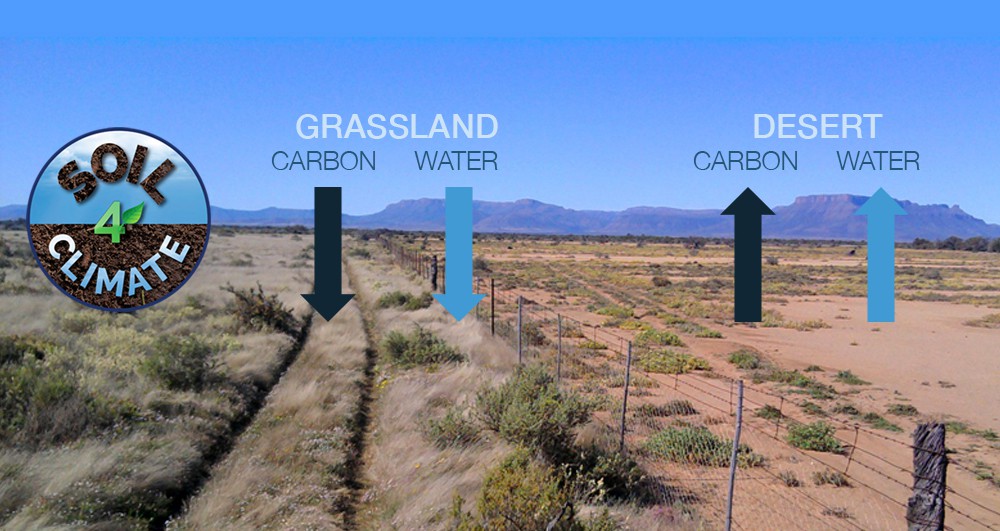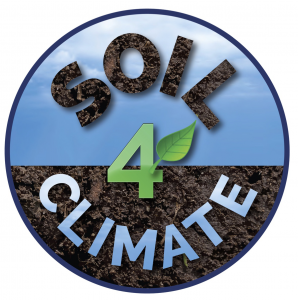Soil 4 Climate – Soils are Key to Reducing Carbon Emissions
Photo credit: Kroon Family
Many people have heard about the 350 movement to reduce carbon emission down to 350 ppm, but few have heard of the 4/1,000 or 4 per 1,000 initiative.[1] Started in France, the initiative aims to introduce agriculture as part of the solution for climate change by carefully managing land to restore carbon stock at an annual growth rate of 0.4%.[2] If every country were to do so, it would cut down annual atmospheric carbon dioxide by 75%. For more about the initiative, please visit 4 pour 1000.
The role of soil as carbon storage has long been recognized, yet little has been done to include soil as a part of the climate solution. Organizations such as Soil4Climate are working hard to bring soil to the forefront of climate discussions. Through a series of educational seminars, public outreach, social media campaigns and partnerships, Soil4Climate is actively advocating for the restoration of soil carbon in order to combat climate change.
Prior to last year’s 21st Conference of Parties in Paris, scientists have already issued warnings that the mean global temperature is heading toward a greater than two degree Celsius increase in upcoming years, which will unleash catastrophic weather-related events. The Conference of Parties – also known as the UN Climate Change Conference – is an annual Conference gathering representatives from every country to discuss climate-related policies and issues, with the hopes of coming to an agreement on future goals to alleviate drastic climate change. During the Conference, delegates from 188 countries came together to discuss their next step of action to reduce climate change impacts.[3] Once again, one of the most central discussions is the reduction of greenhouse gas emission, particularly those of carbon. Yet some scientists took a more skeptical view of the countries’ emission reduction schemes, contending that merely stopping emissions at this point will still bring on damaging weather events, as there is a lag period between emission reduction and actual atmospheric greenhouse gas decline.[4]
For Soil4Climate and the French Ministry of Agriculture, they have the answer: right beneath our feet. Soils store an incredible amount of carbon. In fact, up to 75% of terrestrial carbons are found in soils![5] Unfortunately, poor land management and intense resource extraction have taken a hefty toll on our soils, and approximately 50 to 70% of the original carbon stocks in cultivated soils have already been lost to the atmosphere.[6] Thus careful management is needed to reverse this trend and restore the carbon back into the soil.
Soil4Climate’s co-founder and co-director Seth Itzkan spoke enthusiastically at the Jamaica Plain Forum earlier April this year about the need to expand soil’s carbon sink capacity to drawdown carbon from the atmosphere (see the complete video of his talk). His talk showcased easy-to-understand diagrams of the carbon sources and sinks in the world, along with new findings about glomalin structures on top of plant and hyphae roots which potentially constitute up to 30% of soil carbon.[7]
Dr. Thomas Goreau and Greg Watson serve on the boards of directors of both Soil4Climate and Remineralize the Earth. Soil4Climate is seeking innovative practices and techniques to restore carbon into the soil, among which include the integration of soil remineralization into agricultural practices.
Other useful resources can be found at Soil4Climate’s ‘Resources’ sections which includes a selection of videos and talks about carbon sequestration using agriculture practices. Please visit the organization’s site for more information. Please also see the video of Dr. Thomas Goreau’s keynote address to the Biodiversity for a Livable Climate conference at Tufts University: The Down-to-Earth Solution to Global Warming: How Soil Carbon Sequestration Works.
Zu Dienle Tan recently graduated from the University of Michigan with a Master’s degree in natural resources and environment. She specializes in conservation ecology and is passionate about biodiversity conservation, agroecosystems and sustainable development.
References
[1] http://newsroom.unfccc.int/lpaa/agriculture/join-the-41000-initiative-soils-for-food-security-and-climate/[2] http://newsroom.unfccc.int/media/408539/4-per-1000-initiative.pdf[3] [4] https://www.theguardian.com/environment/2014/nov/02/rapid-carbon-emission-cuts-severe-impact-climate-change-ipcc-report
[5] http://www.esa.org/esa/wp-content/uploads/2012/12/carbonsequestrationinsoils.pdf
[6] http://e360.yale.edu/feature/soil_as_carbon_storehouse_new_weapon_in_climate_fight/2744/
[7] http://mycorrhizae.com/wp-content/uploads/2013/03/Glomulin-Provides-the-Ties-That-Bind-PDF.pdf
Support us on Patreon
Thank you for joining us today! Please become a member of RTE and support us on Patreon. Unlike many larger organizations, we work with a team of determined and passionate volunteers to get our message out. We aim to continue to increase the awareness of remineralization to initiate projects across the globe that remineralize soils, grow nutrient dense food, regenerate our forests’ and stabilize the climate – with your help! If you can, please support us on a monthly basis from just $2, rest assured that you are making a big impact every single month in support of our mission. Thank you!









Got something to say?